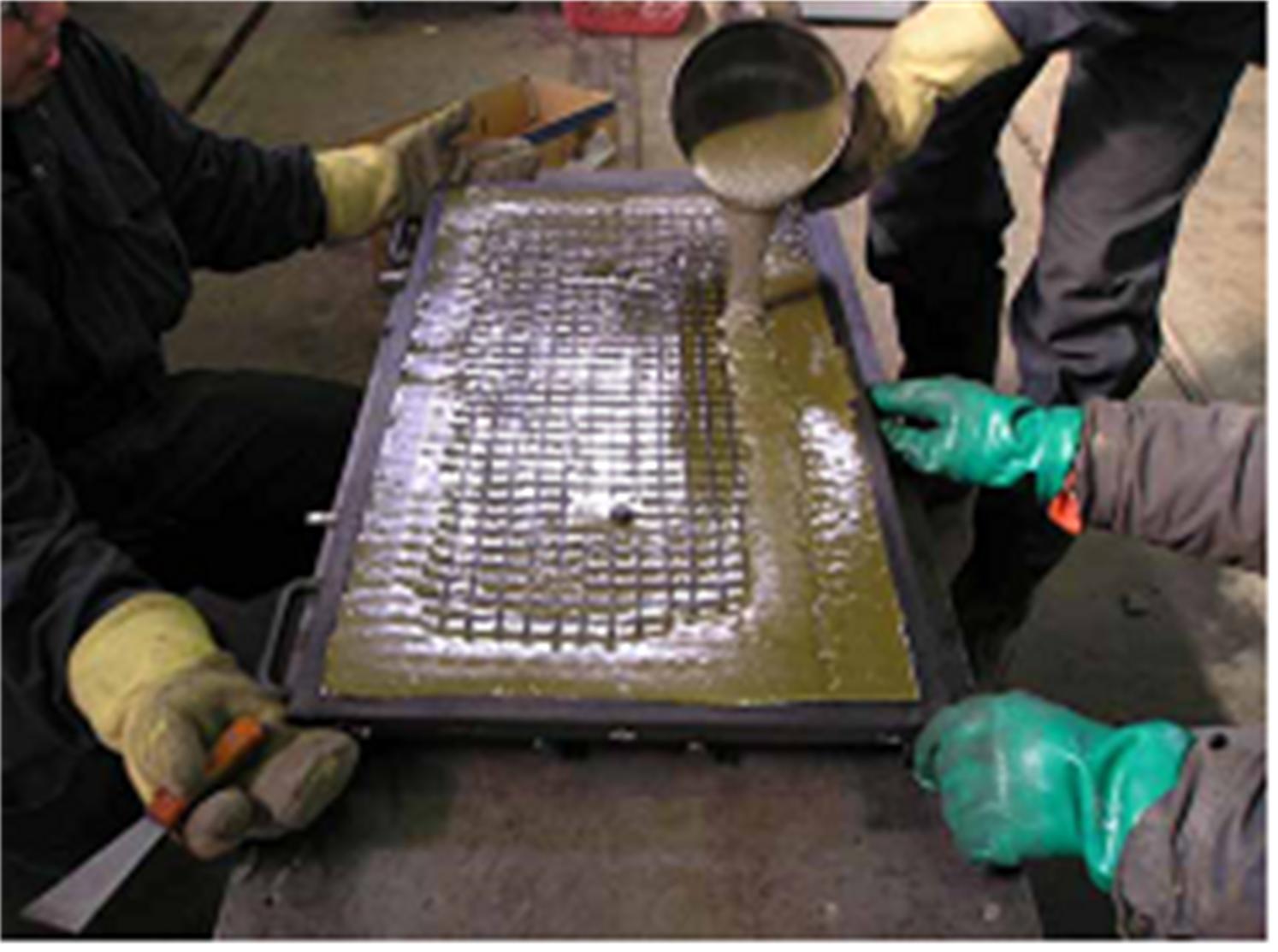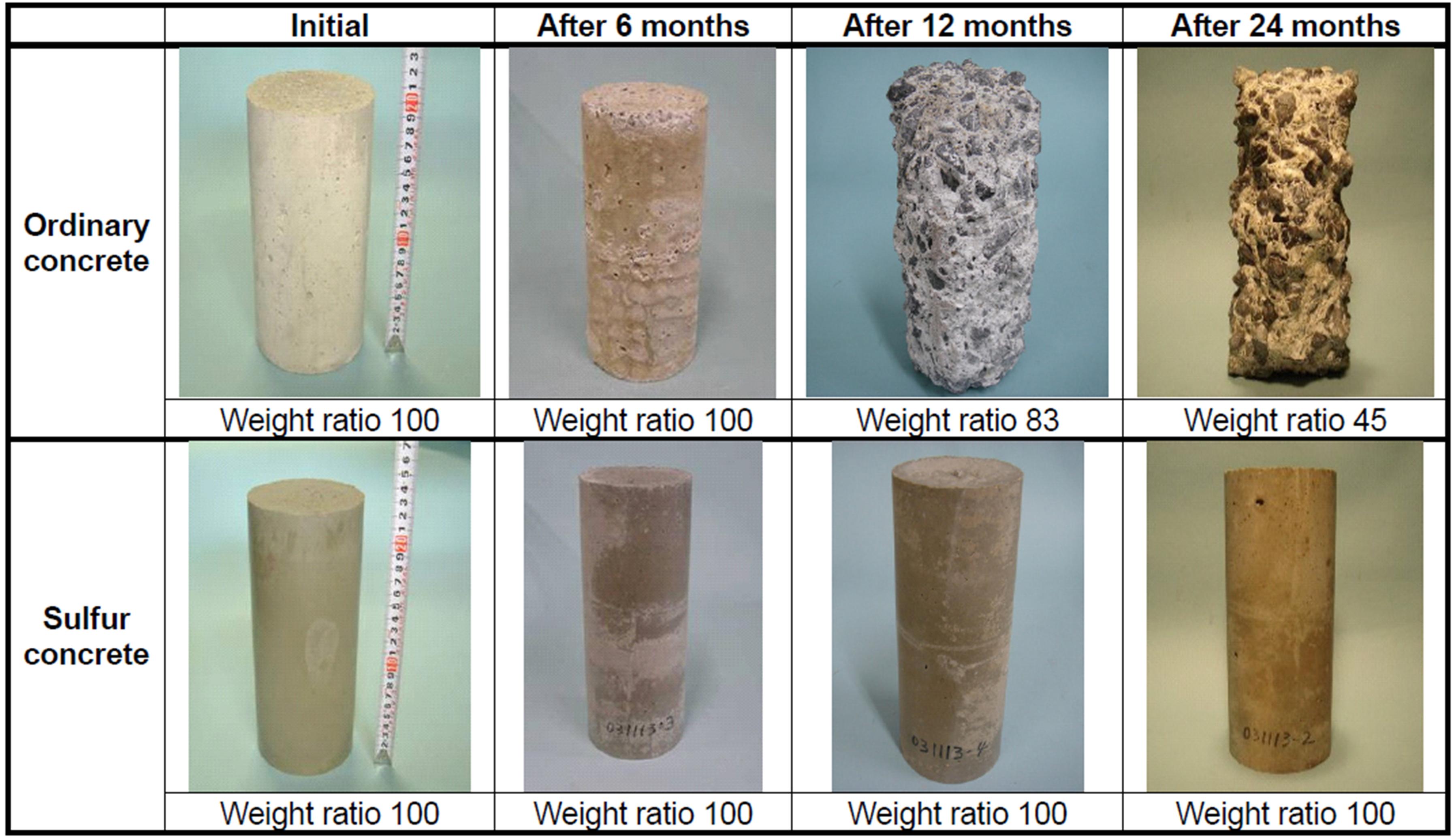Managers of sewage works have been eagerly looking forward to the development of durable anticorrosion covers, because of the rapid corrosion (of about 6 mm per year) that ordinary-concrete structures undergo on account of sulfuric acid derived from hydrogen sulfide that is generated in sewage (Photograph-1).

Photograph-1 Corrosion state of reinforcement after removal of deteriorated portions
When burnt, sulfur contained in crude oil gives rise to atmospheric pollution in the form of sulfur oxides, for which reason sulfur is removed during oil refining. This byproduct sulfur is used as a raw material for synthetic fibers, synthetic detergents, fertilizers and the like. The usage amount of such sulfur, however, is approaching saturation, and thus novel ways of utilizing the sulfur have been explored. To that end, sulfur concrete (Recosul) has been developed that is stronger than ordinary concrete. This sulfur concrete is obtained by adding additives etc. to sulfur as a raw material. The applications of sulfur concrete, for instance in marine facilities, have been growing ever since.
Against such background, the ECOSULFUR anticorrosion method (hereafter, present method) has been developed by focusing on the acid resistance and strength of sulfur concrete, with the aim of achieving durable anticorrosion covering against sulfuric acid corrosion in ordinary-concrete structures for sewage works.
Among conventional anticorrosion cover methods, coating-type lining methods (on-site coating) have shortcomings in that the coating detaches readily, and once detachment occurs, it spreads continuously (Photograph-2, Figure-1). Sheet lining methods (covering with factory products) are also problematic in terms of low rigidity and vulnerable joints (Figure-2). In both methods, most of the anticorrosion cover members that are used are organic materials in the form of refined petroleum products.

Photograph-2 Detachment of coating-type lining

Figure-1 Issues in coating-type lining methods

Figure-2 Issues in sheet lining methods
2.1 Positioning of the present method in ordinary-concrete anticorrosion cover methods for sewage works
The specifications of the present method are aimed at category D2, which applies to the harshest design corrosive environments, where extreme corrosion of ordinary concrete occurs due to sulfuric acid, and yearly-average hydrogen sulfide concentration is of 50 ppm or higher.
The present method can be classified as a post-affixing method, among sheet lining methods, which involves repair of sections once the deteriorated portions have been removed, and bonding of the anticorrosion cover members using an adhesive or the like (Figure-3).

Figure-3 Method classification
2.2 Characteristics of the anticorrosion technique
The present method differs significantly from conventional anticorrosion techniques as regards the four features below.
- The anticorrosion cover member utilizes effectively sulfur and coal ash, which are byproducts of petroleum refining and of thermo-electric power plant respectively. This ensures the sustainability of the technique, in terms of material procurement and lower environmental impact.
- The main anticorrosion cover member (sulfur concrete panel) is made up of an inorganic material, and is hence highly durable.
- The method contributes to reducing environmental impact, by virtue of CO2 emissions that are lower by 50% vis-à-vis those of cement products.
- The anticorrosion cover member does not come off.
2.3 Mixture of sulfur concrete
• Mixture
- Sulfur concrete, MS (milk sulfur) : silica sand=40:60 (weight ratio)
- MS mixture, modified sulfur : coal ash=2:1 (weight ratio)
- Modified sulfur: Pure sulfur modified through the addition of additives contributes to increasing of strength, etc.
- MS: Pure sulfur is a hazardous substance according to the Fire Service Act. However, the pure sulfur is made into a non-hazardous substance MS by being kneaded with appropriate amounts of coal ash. Doing so enhances the versatility of sulfur, in terms of handleability during transportation, etc.
- Silica sand: Using silica sand in half or more of the blend contributes to reducing costs and reducing also thermal shrinkage associated to solidification, during natural cooling (slow cooling) after melting.
2.4 Manufacture and quality control of sulfur concrete panels
The features below were developed in order to manufacture panels by utilizing the thermal characteristics of sulfur concrete (melting at 120°C, solidification upon slow cooling). The materials in MS are stable, and exhibit hence no uneven coloration.
First stage:
- Sulfur concrete blends for ensuring fluidity during manufacture and smoothness after solidification.
- Consideration of panel shape, dimensions and thickness, and enhancement of impact strength
- Equipment for melting/kneading MS and silica sand efficiently, and for maintaining the temperature of the melt
- Molds for forming panels, and heating equipment for molds
- Method for melt pouring (Photograph-3)
- Demolding equipment
- Quality control (control of warp and deflection using a limit gauge)

Photograph-3 Melt pouring
2.5 Characteristics of sulfur concrete panel
• The weight per panel is set at 8 kg with handling by labors in mind. The dimensions are set at 400 ´ 800 ´ 12 mm (Photograph-4) to reduce the influence of thermal shrinkage and to improve construction efficiency ® Enhanced workability in narrow spaces, quality assurance.
• Meshed carbon fibers are placed through-thickness center of the panel. As a result, impact strength increases by ten times, and piece detachment is prevented during earthquakes. ® Enhanced impact resistance and earthquake resistance
• On-site cutting work can be easily performed using a sander or the like. ® Improved workability
• High strength is achieved: compressive strength 55 N/mm2, flexural strength 10 N/mm2 ® Enhanced durability

Photograph-4 Sulfur concrete anticorrosion panel
2.6 Characteristics of the present method as anticorrosion cover members
(1) Non-detaching structure
Occurrence of detachment is not a concern, since, with a thickness of 12 mm, the anticorrosion panel is highly rigid, and is fixed mechanically with anchors (M-8: 6 pieces/m2), in addition to being bonded over the entire surface using an acid-resistant adhesive (1.5 N/mm2 or higher). As a sheet lining method, therefore, the present method can fully cope with the level-2 earthquake. During affixing of the panels, the joints are also filled with an acid-resistant adhesive over a width of 3 mm (Figure-4).

Figure-4 Structure of the ECOSULFUR anticorrosion method
(2) Construction method for enhancing bonding effect (Figure-5) and reliable joints (Figure-6)

Figure-5 Panel bonding method
Conventional sheet lining methods require not only a platform for ceiling work, but also scaffolding up to the ceiling, in order to support anticorrosion cover members. This scaffolding requirement is a hindrance for material conveyance and personnel traffic. In the present method, the panels can be placed and fixed using anchor bolts, and hence work at a height can be made safer simply by standing on a platform (Photograph-5).
In the joining work, the same material is used for the adhesive and the joints. Therefore, joints can be formed by pushing the material out from the rear face of the panels, through pressure bonding during panel affixing (Figure-6).

Figure-6 Joint structure
3. Development history
3.1 Proof of the superior acid resistance ability of sulfur concrete
Acid resistance was experimentally verified on the basis of a 2-year exposure test in a harsh sewage corrosive environment where the yearly-average concentration of hydrogen sulfide exceeded 200 ppm. Ordinary concrete specimens exhibited 55% corrosion after 2 years, whereas sulfur concrete exhibited no corrosion at all. This demonstrated the superior acid resistance of sulfur concrete (Figure-7).

Figure-7 Exposure test in sewage corrosive environment (hydrogen sulfide concentration ³ 200 ppm)
3.2 Manufacture of sulfur concrete panels
Development aimed at manufacturing panels by utilizing the thermal characteristics of sulfur concrete was done for 4 years, since 2003 (see 2.4 for details).
3.3 Construction Technology Review and Certification; Spread of the Technology
In March 2006 the Construction Technology Review and Certification (sewage works technology) was granted by the Japan Institute of Wastewater Engineering Technology.
Our track record since 2006 and unceasing introduction of improvements has accrued to a growing know-how. In our endeavor towards popularizing the technology and ensuring construction quality, we have drafted, a construction manual for engineers in the field of corrosion prevention.
4. Development results
In some instances, coating-type anticorrosion method requires maintenance and repair due to detachments and the like that occur within a relatively short time in harsh sewage environments. The operating losses incurred on account of work costs and facility shutdown are significant. The present method affords structures having excellent durability, and hence enables almost-permanent usage. A life cycle cost comparison reveals that the present method is superior in terms of cost, over 10 to 15 years of use, as compared with a coating-type method that incurs accumulating repair costs.
Moreover, no detachment occurs in the present method, which is hence superior to conventional sheet lining as regards durability.
5. Track record
As of the end of 2009, the anticorrosion surface area that has been laid by the present method since 2006 exceeded 5000 m2 in construction projects for local governments in Tokyo, Kobe, Yokohama, Hokkaido, Aomori, etc. The present method has the top share among the 8 methods of the Sheet-Lining Method Association.
As of the end of 2009, the technique has been licensed to 76 firms, and work systems have been established from Hokkaido to Okinawa (North to South). Some construction projects are illustrated below (Photographs-5, 6).

Photograph-5 Walls and ceiling in inflow channel

Photograph-6 Walls and ceiling in balancing reservoir